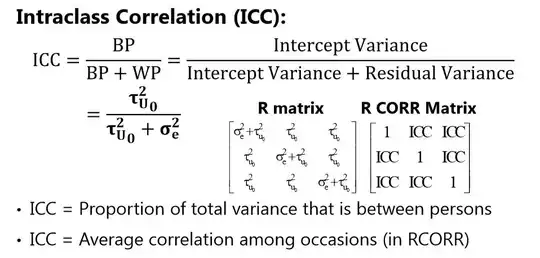Note: the discussion below is largely copy/pasted from my answers in the following threads:
Our model for the $i$th response by the $j$th individual is
$$
y_{ij} = \beta_0 + u_{0j} + e_{ij},
$$
where the random intercepts $u_{0j}$ have variance $\sigma^2_{u_0}$ and the residuals $e_{ij}$ have variance $\sigma^2_e$.
Now, the correlation between two random variables $x$ and $y$ is defined as
$$
corr = \frac{cov(x, y)}{\sqrt{var(x)var(y)}}.
$$
So to find the formula for intra-class correlation, we use the correlation formula and let our two random variables be two observations drawn from the same individual $j$,
$$
ICC = \frac{cov(\beta_0 + u_{0j} + e_{1j}, \beta_0 + u_{0j} + e_{2j})}{\sqrt{var(\beta_0 + u_{0j} + e_{1j})var(\beta_0 + u_{0j} + e_{2j})}},
$$
and if you simplify this using the definitions given above and the properties of variances/covariances, you end up with
$$
ICC = \frac{\sigma^2_{u_0}}{\sigma^2_{u_0} + \sigma^2_e}.
$$
So in this simple case, the ICC works out to be a simple proportion of variance. However it is important to note that this is not always true in general. But what will always be true is that the ICC can be interpreted as the correlation between two (appropriately defined) observations in the dataset. That is the interpretation that is primary.
